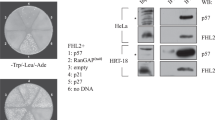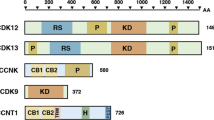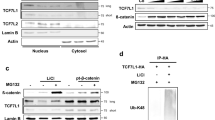Abstract
Activation of the Wnt/β-catenin pathway is a critical step in the development of colorectal cancers. A key mediator of this activation is the recently described oncogene CDK8, which is amplified in a large number of colorectal tumors. CDK8 affects β-catenin activation by interaction of the CDK8 submodule of the mediator complex with β-catenin/TCF transcriptional complex, and by CDK8 interacting with and phosphorylating E2F1, which acts as a repressor of β-catenin/TCF transcriptional activity. The amino-acid residue in E2F1 that CDK8 phosphorylates and how this phosphorylation impacts E2F1 activity in general is not known. Here, we describe that CDK8 phosphorylates serine 375 in E2F1 both in vitro and in cells, and that phosphorylation of this residue is required for E2F1 interaction with CDK8, and that the phosphorylation is dependent on CDK8 kinase activity. The phosphorylation of S375 by CDK8 regulates E2F1 ability to repress transcription of β-catenin/TCF-dependent genes, as well as activation of E2F1-dependent genes. This regulation is due to inactivation of E2F1 transcriptional activation, and not to the interference of E2F1’s ability to bind to E2F1-binding sites in various promoters or to interact with DP1.
This is a preview of subscription content, access via your institution
Access options
Subscribe to this journal
Receive 50 print issues and online access
$259.00 per year
only $5.18 per issue
Buy this article
- Purchase on Springer Link
- Instant access to full article PDF
Prices may be subject to local taxes which are calculated during checkout






Similar content being viewed by others
References
Walther A, Kohnstone E, Swanton C, Midgley R, Tomlinson I, Kerr D . Genetic prognostic and predictive markers in colorectal cancer. Nat Rev Cancer 2009; 9: 489–499.
Firestein R, Hahn WC . Revving the throttle on an oncogene: CDK8 takes the driver seat. Cancer Res 2009; 69: 7899–7901.
Firestein R, Shima K, Nosho K, Irahara N, Baba Y, Bojarski E et al. CDK8 expression in 470 colorectal cancers in relation to β-catenin activation, other molecular alterations, and patient survival. Int J Cancer 2009; 126: 2863–2873.
Moon RT, Kohn AD, DeFerrari GV, Kykas A . Wnt and β-catenin signaling and therapies. Nat Rev Genet 2004; 5: 689–699.
Clevers H . Wnt/β-catenin signaling in development and disease. Cell 2006; 127: 469–480.
Gordon MD, Nusse R . Wnt signaling: multiple pathways, multiple receptors, and multiple transcription factors. J Biol Chem 2006; 281: 22429–22433.
Verma U, Surrabbi RM, Schmaltieg A, Becerra C, Gaynor RB . Small interfering RNAs directed against β-catenin inhibit the in vitro and in vivo growth of colon cancer cells. Clin Cancer Res 2003; 9: 1291–1300.
Agarwal A, Das K, Lerner N, Sathe S, Ciecek M, Casey G et al. AKT/IκB kinase pathway promotes angiogenic/metastatic gene expression in colorectal cancer by activating nuclear factor-κB and β-catenin. Oncogene 2005; 24: 1021–1031.
Kim S, Xu X, Hecht A, Boyer TG . Mediator is a transducer of Wnt/β-catenin signaling. J Biol Chem 2006; 281: 14066–14075.
Taatjes D . The human mediator complex: a versatile, genome-wide regulator of transcription. Trends Biochem Sci 2010; 35: 315–322.
Woychick NA, Hampsey M . The RNA polymerase II machinery: structure illuminates function. Cell 2002; 108: 453–463.
Galbraith MD, Donner AJ, Espinosa JM . CDK8 a positive regulator of transcription. Transcription 2010; 1: 4–12.
Xu W, Ji J-Y . Dysregulation of CDK8 and Cyclin C in tumorgenesis. J Genet Genomics 2011; 38: 439–452.
Firestein R, Bass AJ, Kim SY, Dunn IF, Silver SJ, Guney I et al. CDK8 is a colorectal cancer oncogene that regulates β-catenin activity. Nature 2008; 455: 547–551.
Kapoor A, Goldberg MS, Cumberland LK, Ratnakumar K, Segura MF, Emanuel PO et al. The histone variant macroH2A suppresses melanoma progression through regulation of CDK8. Nature 2010; 468: 1105–1109.
Meyer KD, Donner AJ, Knuessel MT, York AG, Espinosa JM, Taatjes DJ . Cooperative activity of CDK8 and GCNL5 within mediator directs tandem phosphoacetylation of histone H3. EMBO J 2008; 27: 1447–1457.
Knuesel MT, Meyer KD, Donner AJ, Espinosa JM, Taatjes DJ . The human CDK8 subcomplex is a histone kinase that requires Med12 for activity and can function independently of mediator. Mol Cell Biol 2009; 29: 650–661.
Donner AJ, Szostek S, Hoover JM, Espinosa JM . CDK8 is a stimulus-specific positive coregulator of p53 target genes. Mol Cell 2007; 27: 121–133.
Donner AJ, Ebmeier CC, Taatjes DJ, Espinosa JM . CDK8 is a positive regulator of transcriptional elongation within the serum response network. Nat Struct Mol Biol 2010; 17: 194–202.
Rickert P, Corden JL, Lees E . CyclinC/CDK8 and cyclin H/CDK7/p36 are biochemically distinct CTD kinases. Oncogene 1999; 18: 1093–1102.
Fryer CJ, White B, Jones KA . Mastermind recruits CycC:CDK8 to phosphorylate the Notch ICD and coordinate activation with turnover. Mol Cell 2004; 16: 509–520.
Alacron C, Zaromytidou A-I, Xi Q, Gao S, Yu J, Fujisawa S et al. Nuclear CDKs drive smad transcriptional activation and turnover in BMP and TGF-β pathways. Cell 2009; 139: 757–769.
Gao S, Alacon C, Sapkota G, Rahman S, Chen P-Y, Goerner N et al. Ubiquitin ligase Nedd4L targets activated Smad2/3 to limit TGF-β signaling. Mol Cell 2009; 36: 457–468.
Morris EJ, Ji J-Y, Yang F, DiStefano L, Herr A, Moon NS et al. E2F1 represses β-catenin transcription and is antagonized by pRB and CDK8. Nature 2008; 455: 552–556.
Bieda M, Xu X, Singer MA, Green R, Farnham PJ . Unbiased location analysis of E2F1-binding sites suggests a widespread role for E2F1 in the human genome. Genome Res 2006; 16: 595–605.
Ji J-Y, Dyson NJ . Interplay between cyclin-dependent kinases and E2F-dependent transcription. In: Enders GH, (ed.) Cell Cycle Deregulation in Cancer. Springer Science, New York, NY, 2010, pp 23–41.
Tago K, Nakamura T, Nishita M, Hyodo J, Nagai S, Murata Y et al. Inhibition of Wnt signaling by ICAT, a novel β-catenin-interacting protein. Genes Dev 2000; 14: 1741–1749.
Graham T, Clemente WK, Kimelman D, Wu W . The crystal structure of β-catenin/ICAT complex reveals the inhibitory mechanism of ICAT. Mol Cell 2002; 10: 563–571.
Wu Z, Zheng S, Li Z, Tan J, Yu Q . E2F1 suppresses Wnt/β-catenin activity through transactivation of β-catenin interacting protein ICAT. Oncogene 2011; 30: 3979–3984.
Helin K . Regulation of cell proliferation by E2F transcription factors. Curr Opin Genet Dev 1998; 8: 28–35.
Mundle SD, Saberwal G . Evolving intricacies and implications of E2F1 regulation. Faseb J 2003; 17: 569–574.
Krek W, Ewen ME, Shirodkar S, Arany Z, Kaelin WG, Livingstone DM . Negative regulation of the growth-promoting transcription factor E2F1 by a stably bound cyclin 1-dependent protein kinase. Cell 1994; 78: 161–172.
Xu M, Sheppard K-A, Peng C-Y, Yee AS, Piwnica-Worms H . Cyclin A/CDK2 binds directly to E2F1 and inhibits the DNA-binding activity of E2F1/DP-1 by phosphorylation. Mol Cell Biol 1994; 14: 8420–8431.
Peeper DS, Keblusek P, Helin K, Toebes M, van der Eb AJ, Zantema A . Phosphorylation of a specific CDK site in E2f1 affects its electrophoretic mobility and promotes pRB-binding in vitro. Oncogene 1995; 10: 39–48.
Vandel L, Kouzarides T . Residues phosphorylated by TFIIH are required for E2F-1 degradation during S-phase. EMBO J 1999; 18: 4280–4291.
Ohantani K, Nevins JR . Functional properties of a Drosophilia Homolog of the E2F1 gene. Mol Cell Biol 1994; 14: 1603–1612.
Nair JS, Ho AL, Tse AN, Coward J, Cheema H, Ambrosini G et al. Aurora B kinase regulates postmitotic endoduplication checkpoint via phosphorylation of the retinoblastoma protein at serine 780. Mol Biol Cell 2009; 20: 2218–2228.
Hurford RK, Cobrinik D, Lee MY, Dyson N . pRb and p107/p130 are required for the regulated expression of different sets of E2F responsive genes. Genes Dev 1997; 11: 1447–1463.
Bandara LR, Buck VM, Zamanian M, Johnson LH, LaThangue NB . Functional synergy between DP-1 and E2F1in the cell cycle regulating transcription factor E2F/DRTF. EMBO J 1993; 12: 4317–4324.
Zhang J, Li H, Yabut O, Fitzpatrick H, D’Arcangelo G, Herrup K . CDK5 suppresses the neuronal cell cycle by disrupting the E2F1-DP1 complex. J Neurosci 2010; 30: 5219–5228.
Knuesel MT, Meyer KD, Bernecky C, Taatjes DJ . The human CDK8 subcomplex is a molecular switch that controls mediator coactivator function. Genes Dev 2009; 23: 439–451.
DePhoure N, Zhou C, Villen J, Beausoleil SA, Bakalarski CE, Elledge SJ, Gygi SP . A quantitative atlas of mitotic phosphorylation. Proc Natl Acad Sci USA 2008; 105: 10762–10767.
Acknowledgements
We would like to thank Erick Morris for his help and advice. In addition, we would also like to thank Ahmed Samatar, Cynthia Dugan and Yan Wang for their critical reading of this manuscript. In addition, we would like to thank Carlo Toniatti for his help and support.
Author information
Authors and Affiliations
Corresponding author
Ethics declarations
Competing interests
The authors declare no conflict of interest.
Additional information
Supplementary Information accompanies the paper on the Oncogene website
Supplementary information
Rights and permissions
About this article
Cite this article
Zhao, J., Ramos, R. & Demma, M. CDK8 regulates E2F1 transcriptional activity through S375 phosphorylation. Oncogene 32, 3520–3530 (2013). https://doi.org/10.1038/onc.2012.364
Received:
Revised:
Accepted:
Published:
Issue Date:
DOI: https://doi.org/10.1038/onc.2012.364
Keywords
This article is cited by
-
MEKs/ERKs-mediated FBXO1/E2Fs interaction interference modulates G1/S cell cycle transition and cancer cell proliferation
Archives of Pharmacal Research (2023)
-
Knockout of ICAT in Adipose Tissue Alleviates Fibro-inflammation in Obese Mice
Inflammation (2023)
-
Interplay between cofactors and transcription factors in hematopoiesis and hematological malignancies
Signal Transduction and Targeted Therapy (2021)
-
MicroRNA-770 affects proliferation and cell cycle transition by directly targeting CDK8 in glioma
Cancer Cell International (2018)
-
Aberrant expression of CDK8 regulates the malignant phenotype and associated with poor prognosis in human laryngeal squamous cell carcinoma
European Archives of Oto-Rhino-Laryngology (2017)



